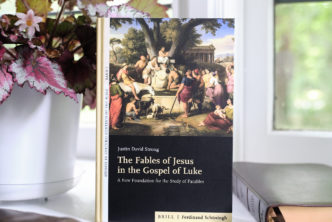Book Review
John G. Gager, William H. Danforth Professor of Religion at Princeton University (Oxford UniversityPress), 2000, 198 pp.
When World War II finally ended in 1945 and thereafter, as the details of the Nazi Holocaust became known, there was an outpouring of shock and outrage unprecedented certainly after any of the other wars of the twentieth century. But it only slowly dawned upon the Christian world that there was somehow at the heart of this horror a whisper, a hint, an unease of conscience or fear that there was something more going on here than simple inhuman brutality. Could there have unwittingly been — only form the words silently on your lips — Christian complicity? Had the words, “His blood be on us and on our children,” written out in Holy Scripture, finally reached the apogee of their trajectory?
Whatever the reasons, among them, perhaps, an uneasy Christian conscience, the years since the second World War have seen the beginnings of a Christian reaching out to Judaism that is without parallel in the two thousand year history of the Church. The story of this historic rapprochement is long and involved and not what is being written about here, but one of the key participants has been Pope John Paul II who spoke the words to the assembled German Rabbinical Conference in the Cathedral Museum of Mainz, November 1980, (referring to the Jewish people): “The people of God of the old covenant never revoked by God.”
The old covenant never revoked? Surely that must mean that Jews and Christians stand seeking justification, each under their own covenant, on an equal footing before the God we both worship. And although the Protestant world does not speak with a single voice much of it has trodden the same theological path.
Until 1977 Christian New Testament scholarship, nearly without exception, drew its understanding of first century Judaism from the works of Ferdinand Weber, E. Schürer, W. Bousset and Paul Billerbeck. Weber was the earliest. In 1880 he published a work in German called System der altsynagogalen palästinischen Theologie, an attempt to work out a systematic theology of Judaism in the time of Jesus and Paul. His student W. Bousset was in turn the teacher of Rudolph Bultmann, perhaps the most influential New Testament scholar in the first half of the twentieth century. Bultmann’s immense reputation was substantially responsible for the more or less uncritical acceptance of Weber’s perspective among contemporary New Testament scholars. And Weber’s view of first-century Judaism was not friendly. He saw the Judaism he wrote about as an incomplete, imperfect, unsatisfactory religion, steeped in legalism and mired down in a system of works-righteousness that had an inaccessible God employed as the accountant-in-chief toting up the good deeds in one column of the record book against the sins of the poor hapless Jew in another.
There were dissenters from this view, C.G. Montefiore for one, and George Foot Moore, who published between 1927 and 1930 a three volume work called Judaism in the First Centuries of the Christian Era: The Age of the Tannaim that should have effectively destroyed Weber’s work. But it didn’t. The world of New Testament scholarship sailed blithely on, ignoring the work of Montefiore and Moore, comfortably ensconced in the arms of a patronizing, if not overtly hostile, conception of Jewish religion in the first centuries of the Christian era. That is, until E.P. Sanders published in 1977 a bombshell of impeccable scholarship called Paul and Palestinian Judaism. With Sanders the gloves came off. He called his shots explicitly, stating that it was his intention to demolish the Weber-Bousset-Bultmann thesis once and for all. And he did, in page after page of detailed references and analysis of the original documents, which until he took the trouble of studying them had been mostly available to scholars only in a series of extracts published by Paul Billerbeck. Sanders showed Billerbeck’s choice of extracts to be biased and tendentious, frequently parading obscure and minority opinions as mainline rabbinical thought and exegesis.
This brings us to Paul. Sanders realized that a new view of Judaism in the first Christian centuries entailed a reevaluation of Paul, and the final section of his book makes a new effort in that direction. Part of the reason Christian scholars had embraced the Weber-Bousset-Bultmann view of Judaism for so long had been that it fit so neatly with the Christian perception of Judaism that Paul seemed to be struggling against, and the Judaism and Pharisaism that is handled so roughly in the Gospels. But the Gospels were all written during an early period when the Church was in open conflict with Judaism, and that writing in those circumstances was polemical in nature and intent.
For two thousand years, Paul has been a bone sticking in the throat of any possible Jewish/Christian dialogue. Throughout much of Christian history, perhaps dating even from the writing of the book of Acts, Paul has been seen as in conflict with Judaism, as attacking the validity of the law, as embracing salvation by grace through faith against the supposedly Jewish concept of justification by works, as rejecting the old covenant in favor of the new, and portraying Israel as replaced by the new creation in Christ. Jews have traditionally seen Paul as either unredeemably heretical or else plain crazy, and they have been unable to discern in Paul’s letters any recognizable Judaism as they know it.
Is it possible Paul has been misread and misunderstood for these two thousand years? This is an issue for both Jewish and Christian scholars, and today, prompted at least in part by new Christian approaches to Judaism, there are many Jewish as well as Christian scholars studying and writing about Paul. This ongoing reevaluation of Paul is far from complete. We are at the stage of debate, not even close to the stage of consensus.
The beginning of the revolution in Pauline studies dates to 1961 when Krister Stendhal, Lutheran Bishop in Sweden and more recently Dean of the School of Divinity at Harvard University, delivered an address later published in the Harvard Theological Review in 1963 entitled, “Paul and the Introspective Conscience of the West.” Among Stendhal’s insights: (1) Paul lived and died a Jew. He had no concept of Christianity (a term unknown to Paul) as a new religion. (2) Paul’s conversion on the Damascus road could not have been “from Judaism to Christianity”. Paul’s own understanding of his experience was that he was thereby appointed by God to be “Apostle to the Gentiles.” (3) It is St. Augustine’s discovery of Paul’s “introspective conscience” and Martin Luther’s focus on “justification by faith” that have led later interpreters to impose meanings on Paul that are diametrically opposite to what Paul actually said.
A succession of scholars have progressively brought Paul closer and closer to his Jewish roots, including E.P. Sanders, James D.G. Dunn, Daniel Boyarin, Lloyd Gaston, Stanley Stowers, and most recently John G. Gager in Reinventing Paul.
Gager begins with a series of antinomies found in Paul’s writings, among them, “Now it is evident that no man is justified before God by the law” (Gal. 3:11), over against, “Do we overthrow the law through faith? By no means. On the contrary, we uphold the law” (Rom. 3:31). Will the real Paul please stand up? Can such contradictions be resolved?
Gager insists they can, and the means to do so is by paying very close attention to whom Paul is speaking, and who it is he is speaking about. For instance, many of Paul’s negative comments about the law are not addressed to Jews in general but rather specifically to a group of his gentile converts, and it is for them, these gentile converts, that the law is of no value or even a curse.
According to Gager, Paul believed that Jesus was sent by God so that gentiles could be saved, not as proselytes to Judaism, but as gentiles through faith in Jesus Christ. When Paul writes to his Galatian converts in Galatians 5:2 “if you receive circumcision, Christ will be of no profit for you,” what he means is, “if you become a Jew then Christ’s mission to save you as a gentile is wasted.”
Did Paul believe then that there were two ways to salvation, one for Jews under the old covenant and one for gentiles through Jesus Christ? Perhaps, in the short term, but not ultimately, for there is one passage where Paul reveals his eschatological beliefs: 1 Corinthians 15:24-28.
Then comes the end when he (Christ) delivers the kingdom to God after destroying every ruler…. When all things are subjected to him (God), then the Son himself will also be subjected to him (God) who put all things under him (Christ), so that God may be everything to everyone (or all in all).
And thus, Gager says, Paul shows himself in the end to be a thoroughly Jewish monotheist.
It may be there are still dozens of books to be written on “the new perspective on Paul” and hundreds of articles in learned theological journals to appear before a scholarly consensus is found. But this speech in the debate is a knockout.
Reviewed by Robert Egolf



